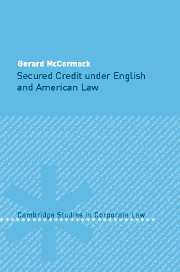Book contents
- Frontmatter
- Contents
- Preface
- List of abbreviations
- 1 The essence and importance of security
- 2 Security rights under English law
- 3 An overview of Article 9 of the Uniform Commercial Code
- 4 Implications of Article 9-type reforms for the English law of security interests
- 5 Notice filing versus transaction filing
- 6 Retention-of-title clauses under English law and Article 9
- 7 Receivables financing
- 8 Security interests in deposit accounts, investment property and insurance policies
- Appendix: Article 9 of the Uniform Commercial Code
- Index
2 - Security rights under English law
Published online by Cambridge University Press: 23 July 2009
- Frontmatter
- Contents
- Preface
- List of abbreviations
- 1 The essence and importance of security
- 2 Security rights under English law
- 3 An overview of Article 9 of the Uniform Commercial Code
- 4 Implications of Article 9-type reforms for the English law of security interests
- 5 Notice filing versus transaction filing
- 6 Retention-of-title clauses under English law and Article 9
- 7 Receivables financing
- 8 Security interests in deposit accounts, investment property and insurance policies
- Appendix: Article 9 of the Uniform Commercial Code
- Index
Summary
There are many different types of security right recognised under English law but the workhorse of the secured credit industry has traditionally been the charge and, in particular, the floating charge. The different kinds of security right under English law will be examined in this chapter. The chapter then examines the pressure points for reform of the law and makes some basic comparisons with the functional approach under Article 9 of the American Uniform Commercial Code.
Basic distinctions
There are three basic distinctions: firstly, between legal and equitable security interests; secondly between possessory and non-possessory security interests; and thirdly, between consensual and non-consensual security interests. These various distinctions cut across one another. The main types of security interest are mortgages, charges, pledges and liens – both common-law and equitable liens.
The distinction between legal and equitable security interests is perhaps most confusing to a non-common-law lawyer but it is easy to exaggerate the importance of the distinction in practice. The distinction stems from the historical separation between law and equity and the fact that certain kinds of security right were only recognised in courts of equity, as distinct from courts of common law, prior to the unification of the court structure in the 1870s. For example, a mortgage of future property was void at common law, and consequently any security interest in future personalty must necessarily be equitable in nature. The distinction retains some importance in the context of priorities.
- Type
- Chapter
- Information
- Secured Credit under English and American Law , pp. 39 - 69Publisher: Cambridge University PressPrint publication year: 2004



